Image SEO: 10 Best Practices to Boost Your Search Rankings
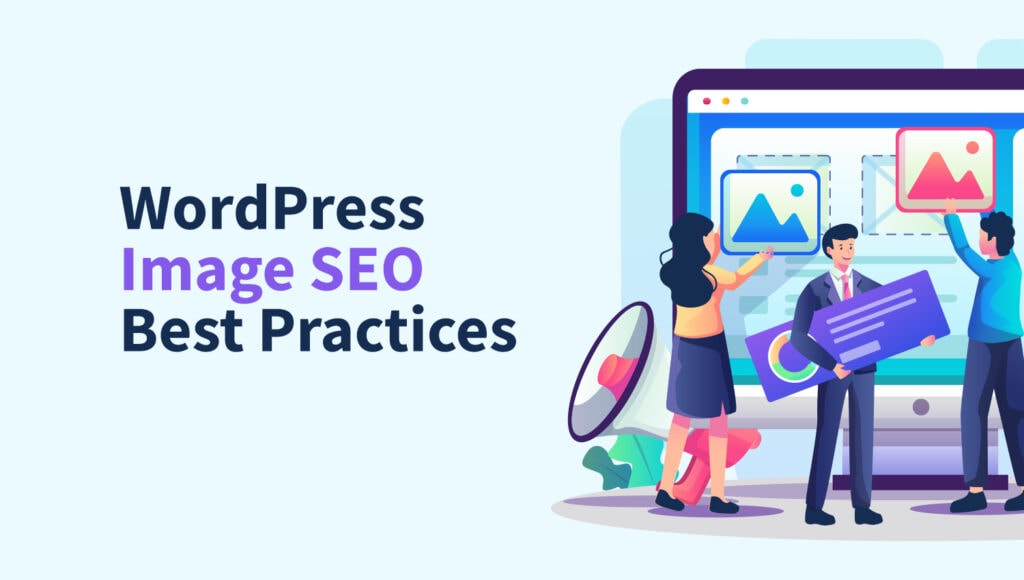
Search engines aren’t just word nerds. They love stunning images just as much as we do.
And guess what?
Pages with optimized images get more attention from search bots because of their proper title, Alt tags, captions, and enough happy visitors to grow your website.
That’s image SEO!
So, let’s go over 10 image SEO optimization tips to help you transform your ordinary images into SEO superheroes.
Let’s get started!
What Is Image SEO?
Image SEO primarily gives the image a proper identity. It helps add context to the image and relevance to the page.
Search engine crawlers can quickly identify images with relevant information such as title, alt tag, and metadata.
The better search engines can identify images, the more effectively they can link them to relevant topics. That’s the essence of image SEO.
It aims to rank images higher on the SERP for image searches. Besides, it seeks to make the page more relevant and rank higher.
Also, image SEO involves resizing, compressing, renaming, and optimizing alt text. It also includes choosing a suitable image format.
Overall, image SEO improves website performance on search engines. It also enhances the user experience on the website.
Why Is Image SEO Important for Better SEO Ranking?
Images make content engaging. Content with images receives 2.3x the engagement as content without images. Image SEO improves the visibility of optimized images on the SERP and impacts the web page’s SEO ranking.
Image SEO has numerous SEO benefits, including:
- Image Identity: Image SEO gives images a proper identity so search engine crawlers can quickly identify, connect, and present them for relevant search queries.
- Increase Dwell Times: A page with engaging images encourages readers to interact with the content. Thus, readers will consume more content and spend more time on the page, extending dwell time and lowering bounce rates.
- Better User Experience: Image alt text optimization helps search engines understand image context. It helps visually challenged readers understand the image, improving the website’s overall user experience.
- Decrease Site Load Time: SEO-optimized images have ideal dimensions and file sizes. Therefore, they improve page loading speed, which is one of Google’s core web metrics.
- Improve CTR: SEO-optimized images appear on the search result as the visual element. It helps to improve the click-through rate. Good CTRs boost SEO ranking by signaling Google’s Rank Brain algorithm.
10 Image SEO Best Practices to Boost Your Search Rankings
As we’ve discussed image SEO and explained why image optimization techniques for search engines are important, let’s explore the best WordPress image SEO practices you can follow to boost your website’s performance:
1. Choose the Right Image Format
The format of an image determines its internal performance and file size. The image file size determines the web page size, which affects your web page’s loading speed.
It also impacts image indexability, as Google supports specific image formats: JPEG, PNG, WebP, SVG, BMP, and GIFs.
Which image format is best for SEO?
Let’s start by learning about some basic features of some familiar image formats:
- JPEG: JPEG image files support lossy compression, resulting in a much smaller file size. It’s the ideal image format when page loading speed is a top priority. However, it loses its original image quality and doesn’t support transparency.
- PNG: PNG employs lossless compression, which results in a larger file size. It makes web pages heavier and takes longer to load. PNG is best for graphics, logos, and transparent images, but it preserves image quality and slows page loading.
- WebP: WebP allows for both lossy and lossless compression. It also includes animation and transparency. According to Google, WebP lossy files are 25-34% smaller than JPEG files, and WebP lossless files are 26% smaller than PNG files. It makes web pages load faster without sacrificing image quality.
2. Compress Images to Faster Loading Time
Image is 21% of a webpage. The larger the image file size, the larger the webpage size. The larger the webpage size, the more time it will take to load. And the cycle goes on.
Image file size also impacts the website’s bandwidth usage. When a user accesses one of your pages with larger images, it requires transmitting more data, increasing bandwidth usage.
Here, image compression comes into play. Compression can reduce image size by up to 90%, significantly reducing the page size. As a result, it increases the webpage loading speed significantly.
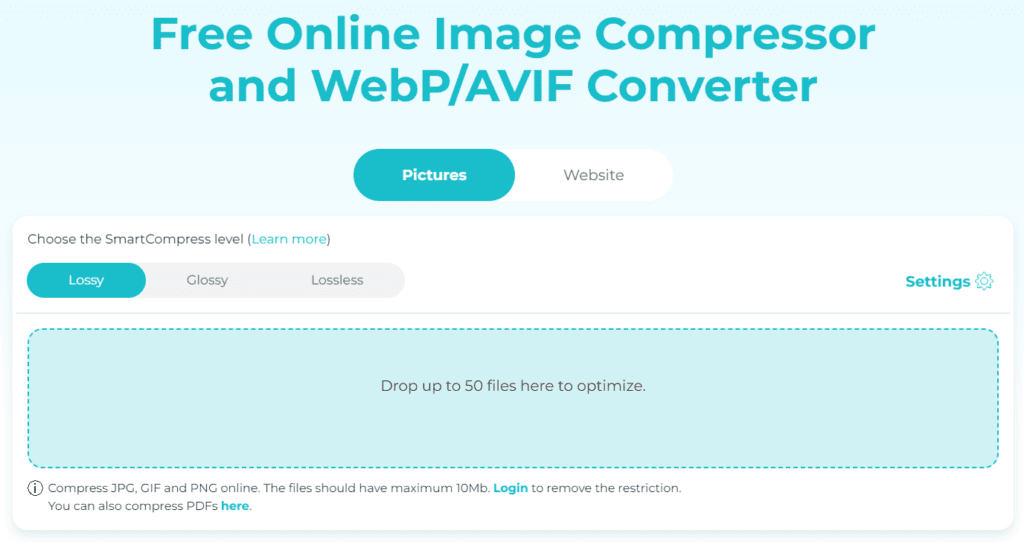
You can use Shortpixel’s online image compressor to compress your images. It can reduce image file size by up to 90%. Besides, it can convert your images to WebP or AVIF formats to save storage and increase SEO performance.
If you need to compress images for your WordPress website, use the Shortpixel image optimizer WordPress plugin.
Shortpixel WordPress plugins automatically compress your website images on upload and existing images. You need to install and activate it and set the settings once.
To save your database storage, you can also convert images to AVIF and WebP formats. It saves storage, increases website page loading time, and performs better SEO.
3. Use Relavant Images In Article
Using the correct and relevant images in your content is vital. They make your writing exciting and help your work improve in online searches. Using images that are relevant to your writing topic improves the overall quality of your content.
For example, a photo of the Statue of Liberty is a good choice if you’re writing about New York. It’s relevant to the topic and helps readers connect better.
- Use your own images: Try to use your own images rather than the ones you find online. Either create one or capture one. Search engines prefer images you create over those taken from others.
- Check for Copyright: Before using any other images, ensure they are free of copyright and trademarks. You can get severe penalties or legal issues using images with copyright tags.
- Give proper image credit: If you use someone else’s image, please give them proper credit. Google can identify every photo using different identity parameters. If you use an image without credit, Google may fine you for copyright misuse.
- Give images proper captions: Not only will relevant images do the work, but proper image naming will help you improve your image’s SEO performance. Say, naming the image statue-of-liberty is fine. But naming it new-york’s-statue-of-liberty connects the Statue of Liberty and New York in a broader sense.
Here’s how to write compelling captions for your photos:
- Keep them short, about 15-20 words.
- Keep them interesting and related to the picture.
- Try to be creative with your captions.
Remember that using relevant pictures with appropriate captions improves and makes your writing more enjoyable. Images are great, but they must align with the content topic.
4. Properly Name Image and Use Image Alt Tags
Search engines can’t see or recognize images like humans. They are robots that can only read text.
Search engines rely on image file names and alt text to understand images. Also, image file names and alt text enable screen readers to convey the image to visually impaired individuals.
These improve website accessibility and user experience. Thus, write image file names and alt text in a way that helps search engines understand the image.
Best practices for image file names:
- Use descriptive file names instead of default names like Photo123.jpeg. For instance, if you sell red hats in your eCommerce store, name the image “red-hat” instead of “hat.”
- Include relevant keywords in the file name.
- Avoid too long file names.
Best practices for image alt text:
- Write alt text to allow readers to visualize the entire image without seeing it.
- Incorporate relevant keywords in the alt text.
- Keep alt text concise; avoid making it too long.
5. Use an Image SEO Tool
Image SEO tools are handy for optimizing images for SEO. They let you optimize file names and alt text in bulk.
Some image SEO tools allow you to include filenames and alt text. It saves significant amounts of time. It also helps to add target keywords to images.
Here are some reputed WordPress image SEO tools to manage your image SEO:
ImageSEO.io: ImageSEO.io is one of the best image SEO tools. It applies SEO best practices to image alt text and file names. Using the plugin, you can optimize open graphs for social media platforms like Facebook, Twitter, and LinkedIn.
Yoast SEO: Yoast SEO is the most popular SEO tool. It can help you to optimize images for open graphs and social media. You can also add an XML sitemap using the Yoast SEO plugin.
All In One SEO: All In One SEO is another fantastic SEO tool. It lets you add an image sitemap. Likewise, it allows you to optimize images for social media and open graphs.
| Features / Plugin | ImageSEO.io | Yoast SEO | All In One SEO |
|---|---|---|---|
| Alt Text Optimization | Automatic and AI-assisted | Guided, less focused | Available, broader focus |
| File Name Optimization | Automatic and AI-assisted | Not a specific feature | Not a specific feature |
| Open Graph Optimization | For social media platforms | For social media platforms | For social media platforms |
| Image Sitemap | Not available | Available | Available |
| Specialization | Focused on Image SEO | General SEO with some image features | General SEO with some image features |
| Ease of Use | User-friendly, automated features | User-friendly, more general SEO | User-friendly, more general SEO |
6. Add Images to SiteMap
Search engines can better index and navigate websites with sitemaps. It can include posts, pages, custom post types, and other website content.
You can include all of the content links in your XML sitemap. Likewise, you add all the image links to the image sitemap.
Here is how the image sitemap looks:
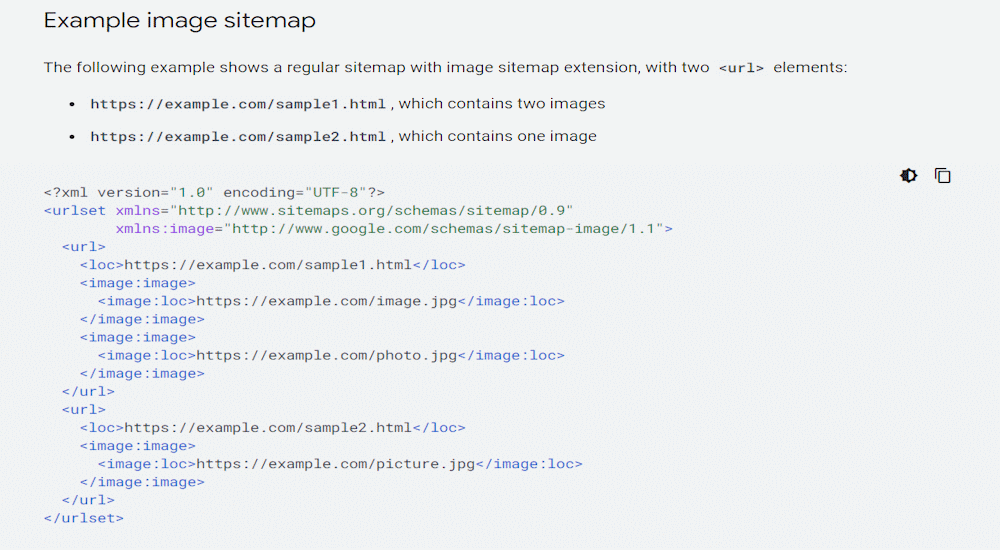
Search engines don’t have a problem indexing text-based content. However, they face indexing issues with images.
An image sitemap helps search engines find and list your website’s images. It improves your pictures’ visibility in Google searches.
If you’re using WordPress, you can add an image sitemap to your site using the All In One SEO plugin:
- Install and activate the All In One SEO plugin.
- Go to the WordPress dashboard and navigate All In One SEO > Sitemap.
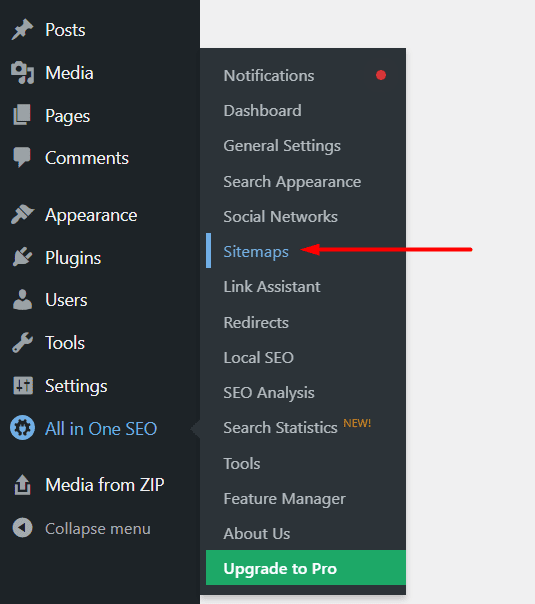
- Scroll to the Advanced Settings tab on the General Sitemaps setting page.
- Ensure that the Exclude Images button is set to No and save changes.
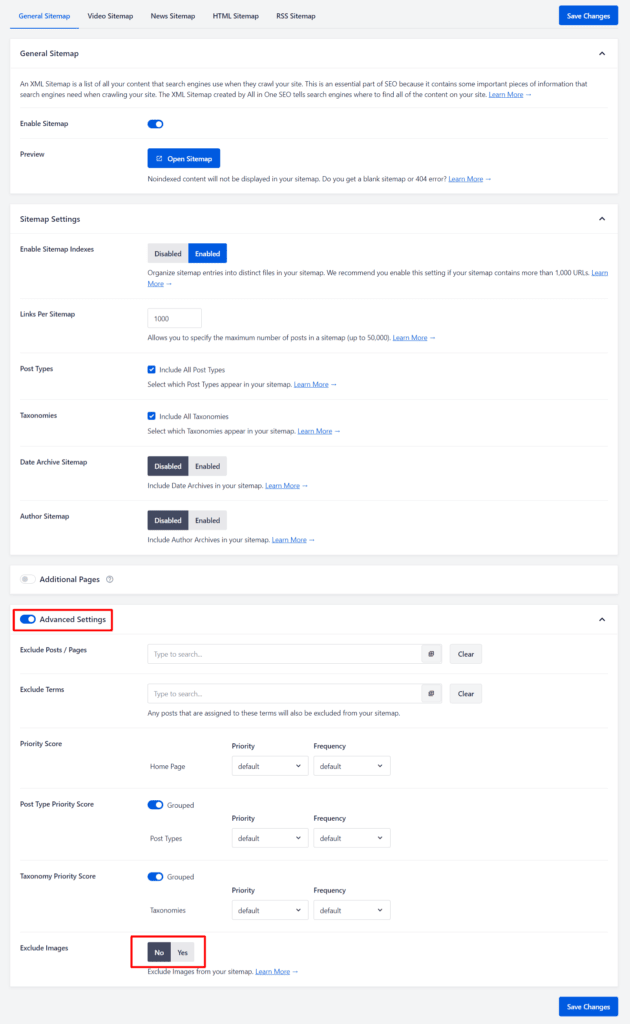
7. Implement Image Lazy Loading
Lazy loading is a method of optimizing content loading on web pages. Instead of loading everything simultaneously, it delays non-critical resource loading until the user needs them.
Laziness is bad for people but great for websites! Lazy loading boosts website performance.
Lazy load significantly improves website loading speed. It eliminates the need to load images at first, enhancing the user experience. It also cuts down on website bandwidth and server load time.
Lazy loading for all pages is a great idea. However, it works better for pages with a lot of large images.
It’s easier than ever to add lazy loading to your website. WordPress now provides native support for lazy loading. If your WordPress version is 5.5 or higher, you don’t need to add lazy load manually.
Here are some of the best WordPress lazy load plugins you can use,
8. Add Image Structured Data
Structured data organizes content on a webpage in a way that search engines can understand.
It uses special codes to add details to content elements, allowing search engines to understand the content better.
ImageObject is a type of structured data explicitly designed for images.
It lets you provide detailed information about the image, such as the title, description, file URL, thumbnail URL, author, and date.
These image attributes aid search engines in better understanding the image’s context and content.
It also boosts image indexability and visibility on SERPs. It also enables a variety of features.
You can use schema.org to add structured data to images. It supplies pre-structured code.
It means you must include image-specific information such as a description and URL.
After you’ve added the image data, paste the structured data into the HTML file header of your webpage.
9. Optimize Images for Open Graphs and Social Media
Most websites rely heavily on social media to drive traffic. To attract social media visitors, ensure your images and content look great on these platforms.
That’s where Open Graph tags come in. Open Graph ensures that your web pages and websites receive accurate previews on social media. It shows various page elements.
Open Graph helps you get the most out of social media:
- It makes your posts look good. When you share something, it’ll have nice pictures and titles.
- It helps people understand the content at a glance.
- It supports social media sites to figure out your content. It means more people may find your posts on these sites.
You can optimize images for social graphs using Yoast SEO:
- Install and activate Yoast SEO.
- Go to the post/page editor you want to optimize for the Open Graph.
- Scroll down and find the Yoast SEO box, then go to Social.
- Now, add an image, title, and description for your preferred social media platform.
10. Use Responsive Images
Images should look great across all screen sizes.
Uploading a large image for small screens will not fit perfectly on the mobile device.
Similarly, if you upload a small image that displays on the desktop screen, it will look blurry.
The result?
Google not only crawls and indexes web pages through mobile browsers. It also ranks pages based on their mobile versions. It is known as the mobile-first index.
If your website’s image is not responsive, it will not rank high on the SERPs. That’s why you must ensure your website’s images are responsive.
If you use WordPress CMS, you won’t have to worry about image responsiveness.
WordPress generates images of various sizes when they are uploaded. It serves them based on screen size.
You can also use WordPress plugins like Shortpixel to resize and compress images.
Summary
These image optimization strategies for your SEO success can help you get the most out of your images and make your website content easier to understand, for both users and search engines. Image SEO plays an essential role in outperforming the competition and delivering a great user experience. SEO image optimization techniques bring benefits like better website ranking, lower bounce rate and overall improved website performance.
We hope our article has helped you better understand the importance of WordPress image SEO optimization and that you have learned how to implement the best techniques. You can start right away by optimizing images, renaming them with suggestive file names and adding alt text.
When it comes to image optimization and compression, we are here to help. Try ShortPixel Image Optimizer – our efficient and easy-to-use plugin. It uses minimal resources and allows you to choose between three levels of compression without compromising on image quality.